Mapping Violent Crimes
One key element of the United States’ crime problem is that violence varies greatly between cities, states, and regions. While Chicago, for example, is infamous for its sheer number of murders, several smaller cities have higher crime rates.
The map below serves to contextualize some of the nation’s violent crime. We have profiled the five U.S. cities with the highest violent crime rates and five cities with the largest populations to highlight the geographic spread of violence in the country.
One of the most prominent issues in the United States today is crime and violence. While the issue of violence is highly politicized, it is important to separate the facts from rhetoric. Here are a few key points about American violent crime.
The FBI has found that overall violent crime in the United States dropped 50% between 1993 and 2015. However, there was a 3% increase in violent crime from between 2014 and 2015. This jump may indicate a slight upward trend in violent crime, but the crime level remains nowhere near the level of the early 1990s.
Americans’ perceptions of the threat of violence differ from the statistics. According to a 2016 Pew survey, 57% of registered voters believed that crime had increased since 2008. By contrast, data from the FBI and the Bureau of Justice Statistics (BJS) indicates a double-digit decline in crime rate over the same time period.
According to The Atlantic, there is currently no distinct explanation for the nation’s drop in crime over the last 25+ years. Some theories for this drop are the increase in incarceration, increased access to abortion, increase in income, and decrease in alcohol consumption, but the topic of crime reduction remains an enigma.

